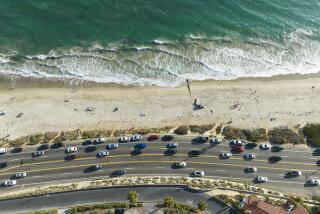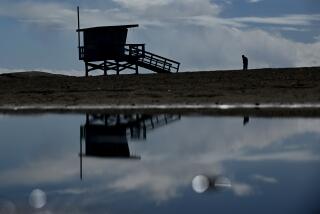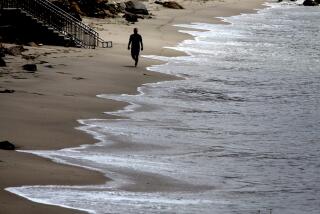Researchers Comb Pacific for Clues to O.C. Pollution
The ocean was calm and cobalt blue about four miles off Huntington Beach on Wednesday morning. But all around, researchers were working feverishly to find out whether the Pacific’s tranquil surface was masking a major coastal threat.
About 200 feet underwater, more than 2,800 gallons of Orange County’s moderately treated sewage spews into the ocean every second--enough waste water in a day to fill the Rose Bowl three times.
In a 48-hour span that ends today, researchers will collect 5,000 water samples to determine whether the plume of sewage is responsible for high bacteria counts that forced health officials to close stretches of Huntington Beach’s shoreline in the summer of 1999.
The results are not expected until next summer.
“It’s extremely frustrating,” said Lisa Lawson, spokeswoman for the Orange County Sanitation District, the agency that releases the sewage. “We would love to go to the community and tell them that we have answers overnight. We can’t do that. We have to wait for the science and analysis.”
The sanitation district and others are conducting the $4.1-million study to test a theory that the sewage plume is being drawn back to shore by internal waves, tides and the ocean-water intake system of the AES power plant on shore. If true, the sanitation district could be forced to make operational changes, including the construction of a new sewage treatment facility, that could cost up to $400 million.
“The easy part is to change operations to fix the problem. The hard part is trying to figure out what the problem is,” said George Robertson, the sanitation district’s chief scientist.
On Wednesday, in the early morning haze, the only visible landmark on land was the AES power plant--ground zero for high bacteria counts in past years.
Four boats darted across the water, surveying the ocean from the surf zone to five miles offshore, testing for water quality during the extreme spring tides. A fifth boat acted as the runner, bringing the sealed samples back to shore, where they were loaded into vans and whisked to the sanitation district’s lab. Ice-packed coolers lined the lab’s hallway with samples awaiting analysis.
Researchers took water samples every five meters from the surface to the ocean floor. An “acoustic Doppler current profiler” also was mounted to a vessel that traversed the 35-square-mile study area and measured ocean current, speed and direction.
This week’s research was the second of six surveys to be completed by mid-September. Eleven moorings also will measure the current every five minutes through October.
With all this money, data and attention to detail, a solid scientific answer would seem to be a given. But in an ever-changing environment like the ocean, answers are often elusive.
*
MORE INSIDE
Seabirds: O.C. oil spill in 1990 prompts a recovery plan. B11
(BEGIN TEXT OF INFOBOX / INFOGRAPHIC)
Testing the Waters
Researchers will complete the second of six scientific surveys today in a $4.1-million effort aimed at figuring out if sewage released four miles offshore is being drawn back to the coast.
More to Read
Sign up for Essential California
The most important California stories and recommendations in your inbox every morning.
You may occasionally receive promotional content from the Los Angeles Times.











